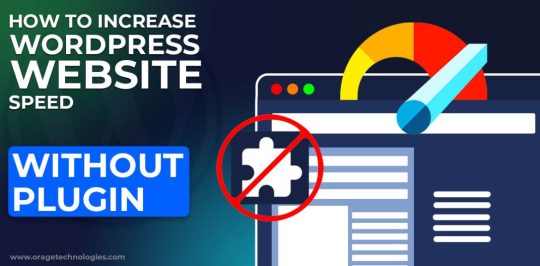#boost your website on wordprees without plugns
Text
How to Increase WordPress Website Speed Without Plugin: Expert Tips for Optimal Performance

In today's fast-paced digital world, the Speed oF Your WordPress website plays a crucial role in user experience, search engine rankings, and overall success. While plugins can be beneficial, optimizing your site's speed without relying on them is equally important. In this guide, we'll explore expert tips to increase your WordPress website speed without plugins.
1. Optimize Images:
Large image files can significantly slow down your website. Use image compression tools like TinyPNG or JPEG Optimizer to reduce file sizes without compromising quality. Additionally, specify image dimensions to prevent unnecessary resizing.
2. Minify CSS and JavaScript:
Minification removes unnecessary characters from CSS and JavaScript files, reducing their size and improving load times. Use online tools or manually remove comments, whitespace, and line breaks from your code.
3. Enable GZIP Compression:
GZIP compression reduces the size of your website's files before they're sent to the visitor's browser, resulting in faster loading times. Most web servers support GZIP compression, which can be enabled through your hosting provider or .htaccess file.
4. Leverage Browser Caching:
By instructing browsers to cache static resources like images, CSS, and JavaScript files, you can reduce server load and speed up page loading times for returning visitors. Set expiry dates for cached content using directives in your .htaccess file.
5. Utilize Content Delivery Networks (CDNs):
CDNs store cached copies of your website's content on servers worldwide, delivering it to users from the nearest location. This reduces latency and improves load times, especially for visitors from distant geographical locations.
6. Optimize Your WordPress Database:
Regularly clean up your WordPress database by removing unnecessary data such as revisions, spam comments, and trashed items. Use plugins like WP-Optimize or WP-Sweep, or execute SQL queries directly to optimize database tables.
7. Implement Lazy Loading:
Lazy loading delays the loading of non-critical resources like images and videos until they're needed, improving initial page load times. WordPress themes and certain plugins may offer built-in lazy loading functionality, or you can implement it manually using JavaScript.
8. Choose a Lightweight Theme:
Opt for lightweight, well-coded WordPress themes that prioritize speed and performance. Avoid bloated themes with excessive features and scripts that can slow down your website.
By implementing these expert tips, you can optimize your WordPress website for speed and performance without relying on plugins. Remember to regularly monitor your website's speed using tools like Google PageSpeed Insights or GTmetrix, and make necessary adjustments to maintain optimal performance. With a fast-loading website, you'll provide users with an exceptional browsing experience and improve your chances of ranking higher in search engine results.
#How To Increase WordPress Website Speed#increase your website speed tips#how to boost your wordprees website#boost your website on wordprees without plugns
0 notes